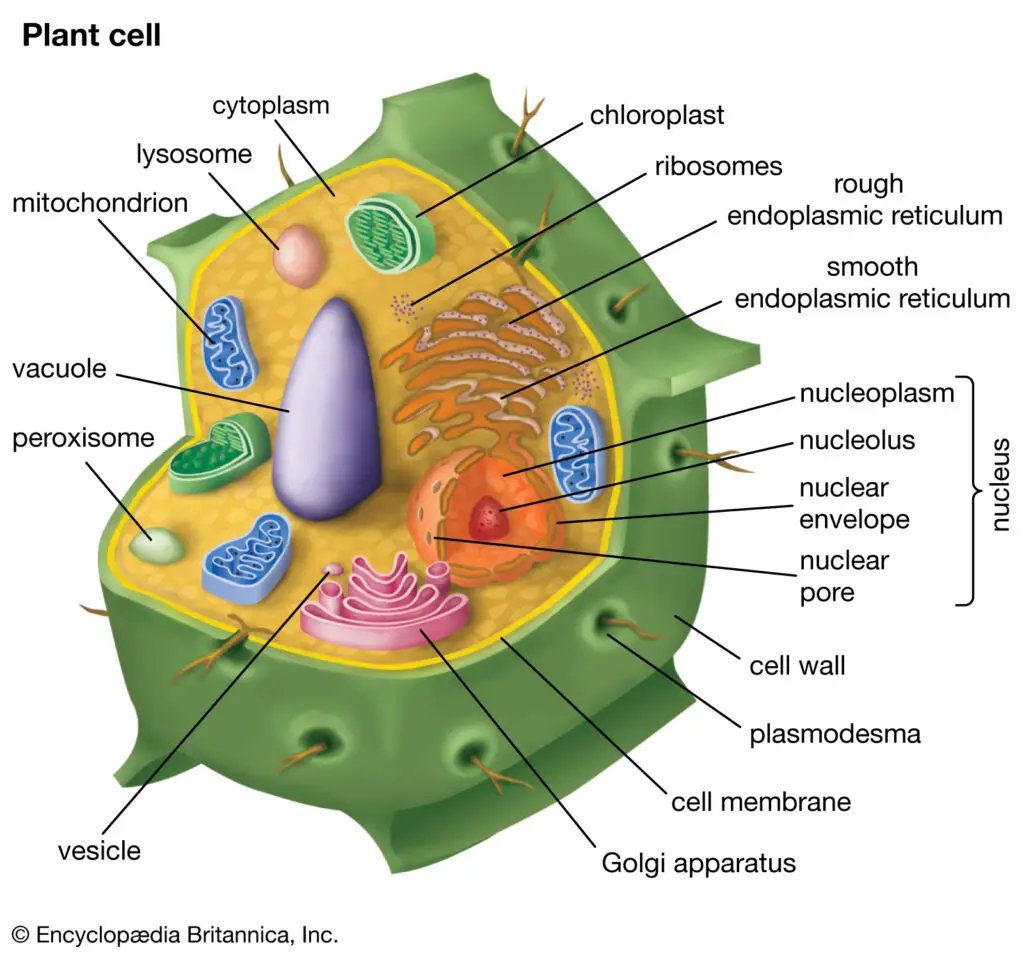In addition to the presence of chloroplasts, another major difference between plant and animal cells is the presence of a cell wall that surrounds the plasma membrane of plant cells and provides tensile strength and protection against mechanical and osmotic stress, and also allows cells to develop turgor pressure, which is the pressure of the cell content against the cell wall.
Plant cells have a high concentration of dissolved molecules in their cytoplasm, whereby under normal conditions water penetrates the cell and the central vacuole of the cell swells and presses against the cell wall. With a healthy water supply, the turgor pressure prevents the plant from wilting. A plant can wither in drought conditions, but its cell walls help maintain the structural integrity of its stems, leaves, and other structures, despite a turgid vacuole that shrinks.
A cell wall is made of cellulose, the most abundant macromolecule on earth. Cellulose fibers are long, linear polymers made up of hundreds of glucose molecules. These fibers are aggregated into bundles of about 40 called microfibrils. embedded in a hydrated network of other polysaccharides. The cell wall is assembled. The precursor components are synthesized within the cell and then assembled by enzymes attached to the cell membrane.
Around the cell there is a cell wall that is a metabolically active and constantly modified structure, which consists predominantly of structurally solid complex polysaccharides. Adjacent cells can be connected to each other by plasmodesmata, pores through the wall where the plasma membrane and the ER connect. Everything that is within the plasma membrane is called the sympathetic nervous system; on the outside, there is only the apoplast, a space impregnated with water in which hydrophilic molecules are present.
Cell walls serve to glue neighboring cells together during the formation of tissues and organs.
THE STRUCTURE OF THE CELL WALL
Almost all plant cells have a primary cell wall. It consists of a long-chain polysaccharide, cellulose, aggregated in bundles into fibers, microfibrils with a diameter of 10-25 nm. The orientation of the microfibrils. it is controlled by the cytoskeleton (see cell wall synthesis below) and the fibers are coordinated so that the plasma membrane is covered in layers.
The orientation of the fibers changes with the development of the cell. Microfibrils have high tensile strength; its resistance is enhanced by the connection between the fibrils through a matrix of hemicelluloses and pectins. Between the cells, there is a middle lamella, a pectic, polysaccharide-rich adhesive region in which neighboring cell walls adhere to one another.
Some fortifying cells and vascular tissues develop a secondary cell wall between the primary wall and the plasma membrane. The fields of secondary cells also contain cellulose microfibers which are inflated with polymerized phenol. Cell walls act as a barrier for pathogens and deter herbivores. Primary cell walls are generally permeable to water and small molecules. The dynamic nature of the primary cell walls enables cell expansion and plant growth.
Plasmodesmata are structures in which the membranes of neighboring cells connect through a pore in the cell wall. They bind the adjacent plasma membranes and the cytoplasm. The demotubule is a tube of the endoplasmic reticulum in the center of the pore, which is surrounded by globular proteins.The structure enables regulated transport between the cells. Plasmodesm compounds, lignins that strengthen the wall. This can be seen in the wood. Lignin protects against wall digestion by fungal enzymes and against the mechanical penetration of fungal hyphae and other pathogens.
The secondary walls are made in layers with the cellulose fibrils oriented in different directions; this “lamination” gives the structure considerable strength.
PLANT CELL WALL SYNTHESIS
The primary cell wall is deposited as the cell grows; Cellulose is deposited by an enzyme complex, cellulose synthase, which appears as a rosette on the membrane; Cellulose is synthesized from uridine diphosphate glucose (glucose UDP), which is added to the end of several strands at the same time, forming a cellulose fiber (or microfibril) on the cytoplasmic side of the membrane. As the strand elongates, the rosette moves on the membrane, extruding the strand so that it runs along the outside of the membrane. Fibers within the cell called the cortical microtubules.
Matrix materials (hemicelluloses, lignin, pectin) are synthesized in the Golgi apparatus and transported in secretory vesicles to the plasma membrane, which releases their contents on the wall. The new material of the wall is deposited on its inside, ie the side adjacent to the plasma membrane.
THE FUNCTION OF THE CELL WALL
Primary cell walls have high tensile strength. They give strength to the stems, leaves, and roots, especially by counteracting the turgor pressure of the cell contents. They show plasticity and elasticity; As the cell grows, the wall’s dynamic structure means it can adapt its structure to accommodate that growth.
A new cell wall forms quickly after cell division. Cell walls avoid contact with plasma membranes except in pores, plasmodesmata. Primary cell walls are permeable to water and low molecular weight molecules (ions, organic compounds, and small proteins) that reach the plasma membrane. This movement is restricted if the wall is lignified or contains suberin, as in the endodermis. The adjacent cell walls adhere to the middle lamella, which creates cell adhesion and enables the formation of tissues and organs.
Cell walls also offer resistance to pathogens and herbivores.

Erzsebet Frey (Eli Frey) is an ecologist and online entrepreneur with a Master of Science in Ecology from the University of Belgrade. Originally from Serbia, she has lived in Sri Lanka since 2017. Eli has worked internationally in countries like Oman, Brazil, Germany, and Sri Lanka. In 2018, she expanded into SEO and blogging, completing courses from UC Davis and Edinburgh. Eli has founded multiple websites focused on biology, ecology, environmental science, sustainable and simple living, and outdoor activities. She enjoys creating nature and simple living videos on YouTube and participates in speleology, diving, and hiking.

